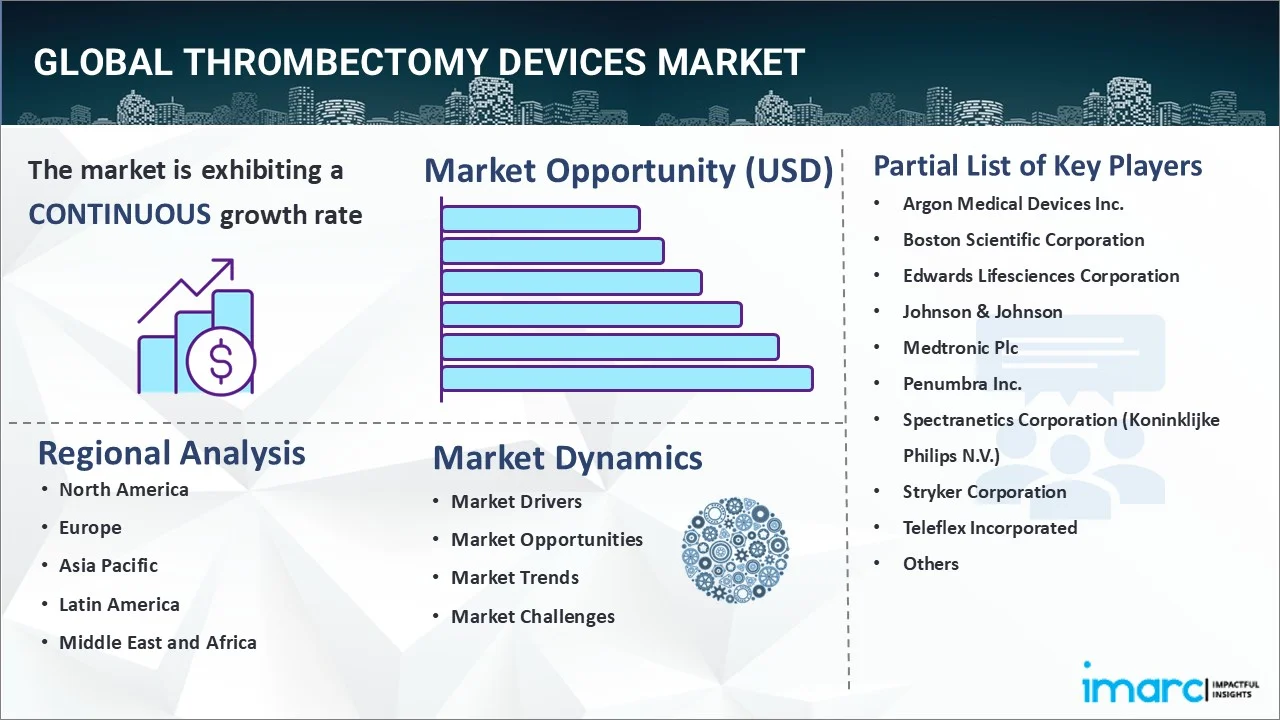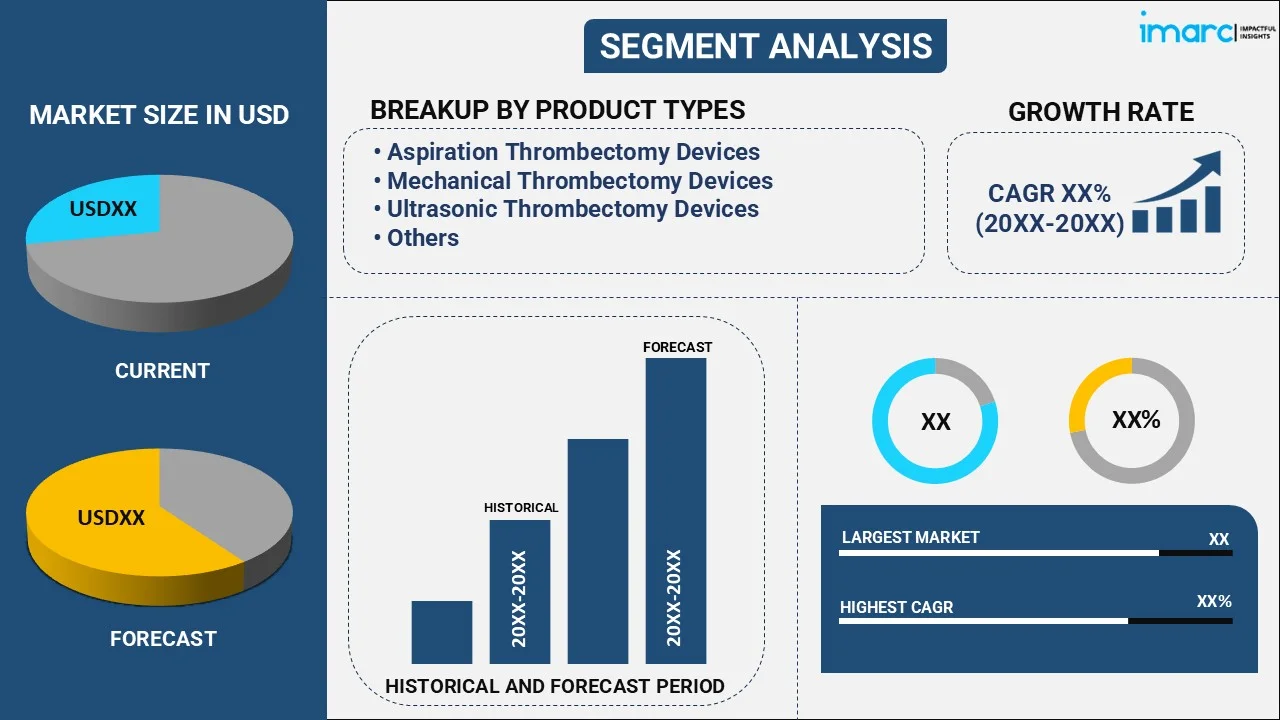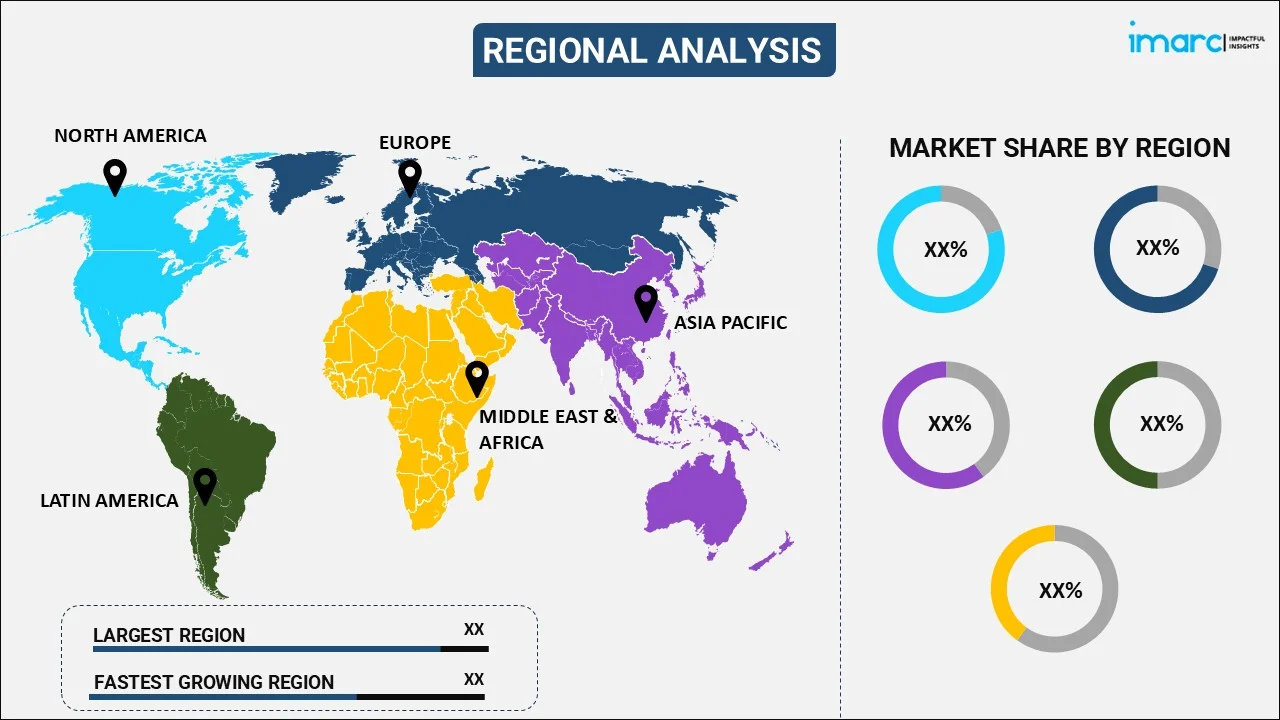
Thrombectomy Devices Market Report by Product Type (Aspiration Thrombectomy Devices, Mechanical Thrombectomy Devices, Ultrasonic Thrombectomy Devices, and Others), Application (Cardiovascular, Neurovascular, Peripheral Vascular), End User (Hospitals and Clinics, Ambulatory Surgical Centers, and Others), and Region 2025-2033
Global Thrombectomy Devices Market:
The global thrombectomy devices market size reached USD 1.41 Billion in 2024. Looking forward, IMARC Group expects the market to reach USD 2.13 Billion by 2033, exhibiting a growth rate (CAGR) of 4.48% during 2025-2033. The rising preference for thrombectomy devices by surgeons to perform image-guided surgeries and continuous improvements in healthcare infrastructures are primarily propelling the market.
|
Report Attribute
|
Key Statistics
|
|---|---|
|
Base Year
|
2024
|
|
Forecast Years
|
2025-2033
|
|
Historical Years
|
2019-2024
|
|
Market Size in 2024
|
USD 1.41 Billion |
|
Market Forecast in 2033
|
USD 2.13 Billion |
| Market Growth Rate 2025-2033 | 4.48% |
Global Thrombectomy Devices Market Analysis:
- Major Market Drivers: The increasing prevalence of chronic diseases, owing to the growing number of individuals who consume alcohol, is one of the key factors stimulating the thrombectomy devices market growth. Furthermore, favorable medical reimbursements by government bodies are also acting as significant growth-inducing factors.
- Key Market Trends: The elevating investments in R&D activities by leading players to introduce technologically advanced thrombectomy devices are among the emerging trends fueling the thrombectomy devices market demand. Moreover, the rising inclination among individuals towards minimally invasive (MI) procedures will continue to stimulate the market over the forecasted period.
- Geographical Trends: According to the thrombectomy devices market overview, North America currently dominates the global market, owing to the rising incidences of venous thromboembolism (VTE) among the geriatric population. Apart from this, extensive public and private funding initiatives by government bodies, especially in the U.S., to create awareness among individuals regarding advanced thromboembolism devices are positively influencing the thrombectomy devices market share in North America.
- Competitive Landscape: As per the thrombectomy devices market research, some of the leading players across the global market include Argon Medical Devices Inc., Boston Scientific Corporation, Edwards Lifesciences Corporation, Johnson & Johnson, Medtronic Plc, Penumbra Inc., Spectranetics Corporation (Koninklijke Philips N.V.), Stryker Corporation, Teleflex Incorporated, and Terumo Corporation, among many others.
- Challenges and Opportunities: One of the primary challenges hampering the thrombectomy devices market revenue includes complex approval processes by regulatory bodies, including the European Medicines Agency (EMA) and the U.S. Food and Drug Administration (FDA). Moreover, ensuring compliance with these regulations can be time-consuming and costly, which can hinder the thrombectomy devices market price. However, extensive investments in R&D activities across the healthcare sector and favorable reimbursement policies by government bodies are expected to drive the thrombectomy devices market value over the forecasted period.

Global Thrombectomy Devices Market Trends:
Rising Cases of Chronic Diseases
According to the World Health Organization (WHO), cardiovascular diseases are responsible for around 17.9 million deaths annually. In addition to this, the Centers for Disease Control and Prevention (CDC) estimates that almost 900,000 individuals in the U.S. are affected by deep vein thrombosis (DVT) and pulmonary embolism (PE). Moreover, the elevating cases of ischemic strokes are also augmenting the thrombectomy devices market revenue. As per a report published by the World Stroke Organization (WSO) in 2022, more than 62% of all stroke incidents are ischemic strokes. Out of these, 55% of ischemic strokes occurred in women and 45% in men. Consequently, the rising cases of chronic diseases among individuals, owing to the elevating consumption of fast food and sedentary lifestyles, are driving the need for thrombectomy devices, as they reduce blood loss and damage caused to the vessel wall during a procedure.
Launch of Novel Devices
The introduction of enhanced thrombectomy devices by key players that are commonly available in various sizes and diameters, depending on the affected area, is one of the primary factors fueling the thrombectomy devices market value. In line with this, they are also significantly investing in R&D activities, thereby positively influencing the global market. For example, Phenox GmbH launched the pRESET 6-50 mechanical thrombectomy device globally to develop its technology for ambulatory surgical centers (ASCs). In addition to this, in January 2023, Penumbra Inc. developed Lightning Flash, an advanced mechanical thrombectomy system with dual clot detection algorithms, following the USFDA clearance. Moreover, Cernuous, part of Johnson & Johnson medical devices companies, introduced EMBOGUARD, a next-generation balloon guide catheter that can be adopted in endovascular procedures, including those for patients with acute ischemic stroke. These devices are gaining traction among surgeons, which are projected to fuel the global market over the forecasted period.
Increasing Focus on Mergers and Acquisitions
Key players across countries are entering into strategic partnerships and collaborating with leading companies to enhance their product portfolio and gain a competitive edge in the market. For example, in September 2021, Abbott announced the acquisition of Walk Vascular, LLC, a commercial-stage medical device company. Due to the acquisition, Abbott gained rights to Walk Vascular's minimally invasive mechanical aspiration thrombectomy system designed to remove peripheral blood clots. In addition to this, in July 2021, Surmodics, one of the leading providers of medical devices and in vitro diagnostic technologies across the healthcare industry, announced the acquisition of privately held Vetex Medical Limited. Furthermore, the growing number of regulatory approvals is also contributing to the market growth. For example, in August 2021, Stryker Neurovascular received regulatory approval from the United States Food and Drug Administration (USFDA) for its Trevo NXT Pro Vue Retriever, a class II medical device classified as a neurovascular mechanical thrombectomy device for acute ischemic stroke. These factors mentioned above will continue to stimulate the thrombectomy devices market statistics over the forecasted period.
Global Thrombectomy Devices Market Segmentation:
IMARC Group provides an analysis of the key trends in each segment of the market, along with forecasts at the global, regional, and country levels for 2025-2033. Our report has categorized the market based on the product type, application, and end user.
Breakup by Product Type:

- Aspiration Thrombectomy Devices
- Mechanical Thrombectomy Devices
- Ultrasonic Thrombectomy Devices
- Others
Currently, mechanical thrombectomy devices account for the majority of the global market share
The report has provided a detailed breakup and analysis of the market based on the product type. This includes aspiration thrombectomy devices, mechanical thrombectomy devices, ultrasonic thrombectomy devices, and others. According to the report, mechanical thrombectomy devices accounted for the largest market share.
The increasing prevalence of ischemic strokes is primarily stimulating the demand for mechanical thrombectomy devices, thereby bolstering the market growth in this segmentation. For example, NeuroVasv introduced the ENVI-SR Mechanical Thrombectomy System (ENVI-SR), a stent-retriever for the removal of blood clots in patients with acute ischemic stroke. Moreover, mechanical thrombectomy devices significantly minimize stroke-related disabilities in patients when used with tPA and other medical treatments. The elevating demand for minimally invasive surgical procedures and favorable reimbursement policies by government bodies for neurovascular and cardiovascular procedures are anticipated to drive the segment's growth over the foreseeable future.
Breakup by Application:
- Cardiovascular
- Neurovascular
- Peripheral Vascular
Among these, neurovascular currently holds the largest market share
The report has provided a detailed breakup and analysis of the market based on the application. This includes cardiovascular, neurovascular, and peripheral vascular. According to the report, neurovascular accounted for the largest market share.
The growing awareness among individuals about neurological conditions, including stroke, is propelling the adoption of thrombectomy devices in neurovascular processes. Furthermore, the US Food and Drug Administration (USFDA) has been collaborating with leading manufacturers and professional societies, such as the National Institutes of Health (NIH) and the NeuroPoint Alliance, to help in developing robust registries that can also be used to generate data for premarket application and post-market surveillance. Besides this, key players are also introducing novel thrombectomy devices to treat acute ischemic stroke (AIS) and its associated symptoms, thereby positively influencing the market growth in this segmentation. For example, in January 2023, Infinity Neuro announced CE Mark approval for its Inspira aspiration catheters.
Breakup by End User:
- Hospitals and Clinics
- Ambulatory Surgical Centers
- Others
Hospitals and clinics exhibit a clear dominance in the market
The report has provided a detailed breakup and analysis of the market based on the end user. This includes hospitals and clinics, ambulatory surgical centers, and others. According to the report, hospitals and clinics accounted for the largest market share.
Hospitals and clinics are preferred by patients as compared to emergency clinics, due to improved healthcare facilities and the easy availability of advanced equipment. Besides this, the rising incidence of acute ischemic diseases and the elevating awareness among individuals regarding thrombectomy devices are some of the primary factors driving the segment's growth. Additionally, specialized departments, operating rooms, advanced labs, etc., in hospitals offer an ideal setting for clot management procedures.
Breakup by Region:

- North America
- United States
- Canada
- Asia-Pacific
- China
- Japan
- India
- South Korea
- Australia
- Indonesia
- Others
- Europe
- Germany
- France
- United Kingdom
- Italy
- Spain
- Russia
- Others
- Latin America
- Brazil
- Mexico
- Others
- Middle East and Africa
North America exhibits a clear dominance in the market
The market research report has also provided a comprehensive analysis of all the major regional markets, which include North America (the United States and Canada); Europe (Germany, France, the United Kingdom, Italy, Spain, Russia, and others); Asia Pacific (China, Japan, India, South Korea, Australia, Indonesia, and others); Latin America (Brazil, Mexico, and others); and the Middle East and Africa. According to the report, North America accounted for the largest market share.
The rising number of individuals suffering from heart attack and cardiac arrest, owing to their hectic schedules and sedentary lifestyles, is primarily driving the thrombectomy devices market in North America. For example, in 2022, the Centre for Disease Control and Prevention (CDC) reported that 805,000 individuals had a heart attack in the United States. Similarly, in 2022, an article published in the National Library of Medicine reported that in the United States, about 610,000 people die of heart disease every year. Consequently, the elevating occurrence of chronic diseases is inflating the need for thrombectomy devices, which is acting as another significant growth-inducing factor. Moreover, favorable reimbursement scenarios for these devices and the expanding healthcare industry are positively influencing the regional market. For example, in August 2021, Stryker Neurovascular received the regulatory United States Food and Drug Administration (USFDA) approval for the Trevo NXT Pro Vue Retriever, a class II medical equipment generally classified as a neurovascular mechanical thrombectomy device for acute ischemic stroke.
Competitive Landscape:
The market research report has provided a comprehensive analysis of the competitive landscape. Detailed profiles of all major companies have also been provided. Some of the key players in the market include:
- Argon Medical Devices Inc.
- Boston Scientific Corporation
- Edwards Lifesciences Corporation
- Johnson & Johnson
- Medtronic Plc
- Penumbra Inc.
- Spectranetics Corporation (Koninklijke Philips N.V.)
- Stryker Corporation
- Teleflex Incorporated
- Terumo Corporation
(Please note that this is only a partial list of the key players, and the complete list is provided in the report.)
Global Thrombectomy Devices Market News:
- March 2024: L&T chairman emeritus A M Naik, investors, such as Madhusudan Kela and Utpal Sheth, along with other high net worth individuals, have invested in medical devices firm S3V Vascular Technologies Ltd to help it set up a facility that will develop neurovascular devices to treat strokes.
- February 2024: Endovascular Engineering Inc., one of the key medical device companies to advance clot removal technologies for venous thromboembolism (VTE), announced the enrollment and treatment of the first patient in the pivotal phase of its ENGULF US clinical trial. This IDE trial will further evaluate the efficacy and safety of the Hēlo PE thrombectomy system, a novel technology, for treating pulmonary embolism (PE).
- January 2024: Surmodics, Inc., one of the leading providers of medical devices in vitro diagnostic technologies, announced the early clinical use of the company’s Pounce LP (Low Profile) thrombectomy system. The Pounce LP thrombectomy system, which received U.S. Food and Drug Administration (FDA) clearance in June 2023, is currently in limited market evaluation (LME), with a full commercial launch planned following the completion of the LME.
Thrombectomy Devices Market Report Scope:
| Report Features | Details |
|---|---|
| Base Year of the Analysis | 2024 |
| Historical Period | 2019-2024 |
| Forecast Period | 2025-2033 |
| Units | Billion USD |
| Segment Coverage | Product Type, Application, End User, Region |
| Region Covered | Asia Pacific, Europe, North America, Latin America, Middle East and Africa |
| Countries Covered | United States, Canada, Germany, France, United Kingdom, Italy, Spain, Russia, China, Japan, India, South Korea, Australia, Indonesia, Brazil, Mexico |
| Companies Covered | Argon Medical Devices Inc., Boston Scientific Corporation, Edwards Lifesciences Corporation, Johnson & Johnson, Medtronic Plc, Penumbra Inc., Spectranetics Corporation (Koninklijke Philips N.V.), Stryker Corporation, Teleflex Incorporated, Terumo Corporation, etc. |
| Customization Scope | 10% Free Customization |
| Post-Sale Analyst Support | 10-12 Weeks |
| Delivery Format | PDF and Excel through Email (We can also provide the editable version of the report in PPT/Word format on special request) |
Key Benefits for Stakeholders:
- IMARC’s report offers a comprehensive quantitative analysis of various market segments, historical and current market trends, market forecasts, and dynamics of the thrombectomy devices market from 2019-2033.
- The research study provides the latest information on the market drivers, challenges, and opportunities in the global thrombectomy devices market.
- The study maps the leading, as well as the fastest-growing, regional markets. It further enables stakeholders to identify the key country-level markets within each region.
- Porter's five forces analysis assist stakeholders in assessing the impact of new entrants, competitive rivalry, supplier power, buyer power, and the threat of substitution. It helps stakeholders to analyze the level of competition within the thrombectomy devices industry and its attractiveness.
- Competitive landscape allows stakeholders to understand their competitive environment and provides an insight into the current positions of key players in the market.
Key Questions Answered in This Report
The global thrombectomy devices market was valued at USD 1.41 Billion in 2024.
We expect the global thrombectomy devices market to exhibit a CAGR of 4.48% during 2025-2033.
The rising prevalence of pulmonary embolism and peripheral arterial diseases, along with the growing demand for thrombectomy devices to minimize blood loss and damage caused to the vessel wall during a procedure, is primarily driving the global thrombectomy devices market.
The sudden outbreak of the COVID-19 pandemic had led to the postponement of numerous elective treatments for diseases related to veins, arteries, capillaries, etc., to reduce the risk of the coronavirus infection upon hospital visits and interaction with medical devices, thereby negatively impacting the global market for thrombectomy devices.
Based on the product type, the global thrombectomy devices market can be categorized into aspiration thrombectomy devices, mechanical thrombectomy devices, ultrasonic thrombectomy devices, and others. Currently, mechanical thrombectomy devices account for the majority of the global market share.
Based on the application, the global thrombectomy devices market has been segregated into cardiovascular, neurovascular, and peripheral vascular. Among these, neurovascular currently holds the largest market share.
Based on the end user, the global thrombectomy devices market can be bifurcated into hospitals and clinics, ambulatory surgical centers, and others. Currently, hospitals and clinics exhibit a clear dominance in the market.
On a regional level, the market has been classified into North America, Asia-Pacific, Europe, Latin America, and Middle East and Africa, where North America currently dominates the global market.
Some of the major players in the global thrombectomy devices market include Argon Medical Devices Inc., Boston Scientific Corporation, Edwards Lifesciences Corporation, Johnson & Johnson, Medtronic Plc, Penumbra Inc., Spectranetics Corporation (Koninklijke Philips N.V.), Stryker Corporation, Teleflex Incorporated, and Terumo Corporation.
Need more help?
- Speak to our experienced analysts for insights on the current market scenarios.
- Include additional segments and countries to customize the report as per your requirement.
- Gain an unparalleled competitive advantage in your domain by understanding how to utilize the report and positively impacting your operations and revenue.
- For further assistance, please connect with our analysts.
 Inquire Before Buying
Inquire Before Buying
 Speak to an Analyst
Speak to an Analyst
 Request Brochure
Request Brochure
 Request Customization
Request Customization




.webp)




.webp)












